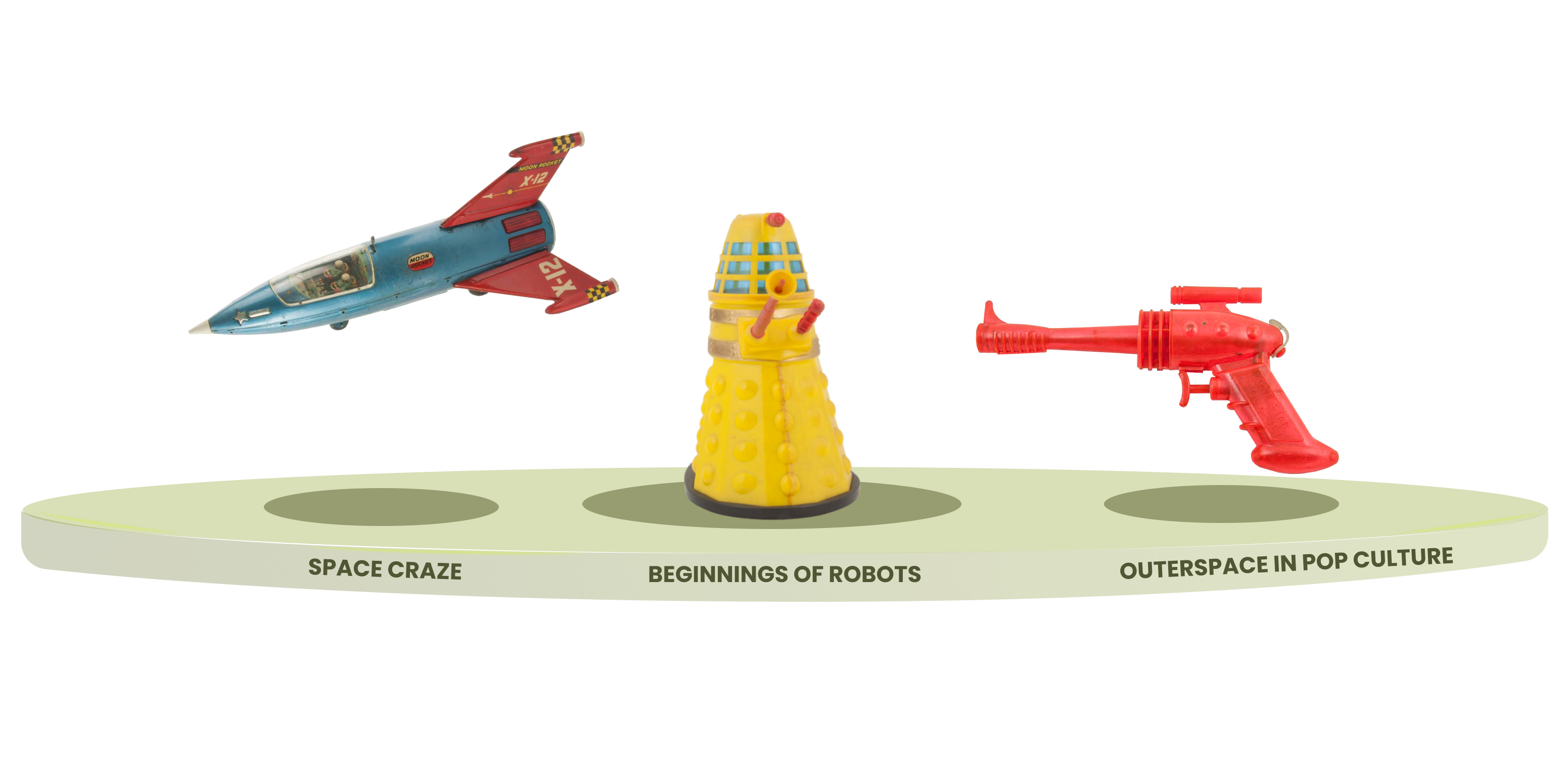
The technological innovations of the present are born out of the vast imaginations of humanity. As portrayed in a variety of toys, astronauts, robots, rockets and aliens are not just mere playthings of the 20th Century. They symbolize humanity’s exploration of possibilities in pursuit for technological modernity.
The possibilities of space travel and artificial intelligence were thought of as radical ideas in the past. However, these ‘radical’ imaginations have eventually progressed into the brilliant innovations which we heavily depend on in our daily lives today.


The exhibition explores a wide array of futuristic outerspace toys which documents the Beginnings of Robots. With the exponential growth in the innovation for space travel from the 1930s to 1960s, the exhibition also documents the Space Craze during the era of the Cold War. In addition, the exhibition investigates the rise of popular outerspace-themed comic books and cinematics through the collection of Outerspace in Pop Culture.


The conception of a mechanical assistant began as early as 3000 B.C. However, the idea of modern robots only began to take flight in the 1920s from the Czech play R.U.R where the term ‘robota’ comes from. By 1958, a robot named ‘Shakey’ was finally designed and used for industrial purposes. Today, the existence of robots has far exceeded our initial conception of a bulky box-like assistant. Artificial Intelligence now exists as a convenient software that is deeply embedded in any devices we use today. Under the collection of Beginnings of Robots, our collection highlights the various shapes of robots such as Robots, Humanoid Robots & Astronauts based on evolving fascination regarding the appearance of artificial intelligence and space exploration.

Robots
Row 1 Shelf 1 – 3
While we tend to associate robots with the technological advancements of modern day society, the history of the concept actually dates back to ancient times. Ancient Greek, Egyptian, and Buddhist texts all contain ideas of autonomous non-human entities that could serve as companions, servants, or soldiers. Craftsmen across various societies would also go on to develop and build self-operating mechanical automata that could perform simple, repetitive tasks – think animatronic
attractions at theme parks, or cuckoo clocks.The modern history of the robot begins in the 20th century, with notable early modern robots including L. Frank Baum’s Tin Woodman from “The Wonderful Wizard of Oz” (1900), and Leonardo Torres y Quevedo’s autonomous chess-playing machine El Ajedrecista (1912). Robots began to enter everyday life during World War I, with the introduction of remote-controlled weapons into modern warfare.
Between the 1930s to 1950s, major breakthroughs were made in the fields of robotics and cybernetics including Isaac Asimov’s publication of “The Three Laws of Robotics” (1941-42), and paradigm shifts in understanding of how data processing could be used in robotics. Unimate (1954), the world’s first digitally operated and programmable robot, and the popularity of Astro Boy (1952-68), also brought robots to the attention of the general public. Since then, the field has continued to advance by leaps and bounds. Today, we are familiar with Sony’s AIBO robot dogs, iRobot’s Roomba vacuum cleaner, and the Mars Exploration Rovers Spirit and Opportunity, which explored the planet Mars in 2003. Robots are now an everyday part of our lives, and new advancements in technology continue to be made daily.

Robot Action Dalek
Row 1 Shelf 4
Science fiction fans will recognise the Daleks, a merciless race of robot aliens determined to conquer the universe. As created by Terry Nation, who modeled them after the Nazis in World War II, the Daleks considered all other life forms as inferior.
First appearing in the 1963 BBC Doctor Who television series, they soon became hugely popular, first in the UK and then the rest of the world.
The first toy Dalek was made by the Louis Marx and Co. and released in 1965. Many other versions by different manufacturers followed.
This 1974 creation owned by the museum is a 6.5 inch yellow Battery Dalek, which was also produced in red. The Doctor Who series is recognised as the longest running science fiction television series in the world, and to-date 13 actors have portrayed the Doctor. The 14th season of this series is scheduled to be broadcast in Nov 2023.

Robot Action Dalek

Maker
Year of Make
Material
Country of Origin
Louis Marx and Company
c.1974
Plastic
United Kingdom


During the 1950s, the Cold War between the United States and the Soviet Union had sparked a competition to achieve spaceflight superiority. With the excessive research and resources allocated for this project, the radical idea of space travel became a rational possibility for humankind.
Since toy makers often produce toys as a response to the political and social landscape of the era, a huge influx of outerspace toys were surging the market throughout the 1950s to the 1960s to feed into this space craze.
Under the collection of Space Craze, our collection charts the variety of space-themed toys manufactured as a response to widespread commercial fascination with the outerspace through the collection of Spaceships and Space Vehicles, Extraterrestrial Life, as well as Space Weapons and Devices.


Spaceships
At the height of the Cold War, the United States of America (USA) and the Soviet Union (USSR) embarked on what would commonly be known as the “Space Race” (1955-1991), aiming to be the first nation to achieve landmark spaceflight achievements. In order to make this possible, extensive research was carried out on designing spacecraft that could transport humans safely into space.
Even before the Space Race, science-fiction works such as Jules Verne’s “From the Earth to the Moon” (1865) and H.G. Wells’ “The War of the Worlds” (1897) already captured the public’s attention and began to generate excitement over the thought of exploring the vast unknowns of space. While several early rockets and satellites such as the German V-2 (1944) and Soviet Sputnik series (1957-58) made it into orbit, the first manned spaceflight was only achieved in 1961 with Yuri Gagarin’s 108-minute orbit of Earth as part of the Soviet Vostok programme. Notable spacecraft series that emerged during the Space Race include the Apollo (1968-75), Space Shuttle (1981-2011), and Soyuz (1967-present).
The Space Race included triumphs such as the Apollo 11 moon landing, as well as tragedies like the Space Shuttle Challenger and Soyuz 11 disasters.
Following the official end of the Space Race in 1991, many countries and companies have launched their own crewed spacecraft into orbit to pursue outer space research. These include the International Space Station (ISS) and the Shenzhou, China’s first crewed spacecraft. Private companies such as SpaceX, Virgin Galactic, and Blue Origin are now exploring options for space tourism, offering consumers the opportunity to travel into space for leisure.

Moon Rocket XM-12
Row 2 Shelf 4
In the year 1950, two directors – George Pal and Kurt Neumann – were engaged in a heated race to release the first postwar outer space film. The American public waited with bated breath for Pal’s film, Destination Moon, which was scientifically accurate due to prolonged consultation with scientists and engineers during its production process. However, Neumann took advantage of the production delays that Pal was facing and rushed out his own film, Rocketship X-M, in just 18 days on a $94,000 budget – snatching away Pal’s desired accolades.
Yonezawa’s “Moon Rocket XM-12” toy is a curious reminder of this forgotten battle. Constructed out of lithographed tin, the rocket comes with replaceable light-up bulbs and two pilots under a clear plastic canopy; a special feature of the toy is that it can be steered using the nose wheel in the cockpit. The toy was first sold in 1958, and its silhouette is a carbon copy of Luna, the spaceship featured in Destination Moon; prior to its release, the film ran a large national print media and radio publicity campaign depicting the cast and the rocket to stoke public interest. Despite this, the toy was ultimately named the XM-12, an homage to Neumann’s film.

Moon Rocket XM-12
Maker
Year of Make
Material
Country of Origin
Yonezawa Toys
c.1956
Lithographed Tin, Rubber and Plastic
Japan


Apart from the mass manufacturing of space toys, the obsession with outerspace was also heavily reflected in popular culture such as the narratives of comic books, cinematic and television films. With the possibility of humankind traveling into the unknown world of outerspace, many of these plot lines feature space heroes fighting against extraterrestrial enemies to save the earth.
Under the collection of Outerspace in Pop Culture, our collection documents some of the most popular outerspace narratives through the collection of Comic Book Space Heroes and Cinematic Space Heroes.

Comic Book Space Heroes
Space exploration and the science fiction imagination of alien encounters reached their peak of optimistic possibility after the first moon landing in 1969. The Space Race, a 20th Century struggle for space superiority between two nation-states, the Soviet Union (USSR) and the United States (US), saw the culmination of space technologies and the limitless possibilities. These two events were significant not only in space exploration in and of itself, but they also influenced art, particularly science fiction. It inspired several artists to take their own spin at speculative fiction, traversing worlds beyond Earth and, ultimately, reality.
One of the most famous space heroes to emerge in the pages of comic books was Dan Dare (1950-present). Attention was paid to scientific possibilities, with the comic set mostly on planets of the Solar System presumed to have extraterrestrial life and alien inhabitants. Another popular spaceman protagonist, Buck Rogers (1929-present), made his debut in Armageddon: 2419 A.D. (1928-29), serialised in Amazing Stories (1926-present). To a lay audience, the strip introduced and popularised science-fiction paraphernalia and concepts such as ray guns, robots, and rocket ships that were previously written only in pulp magazines.
Even today, speculative space fiction is still very much popular in the comic world. It has been utilised by popular comic companies like Marvel and DC, with each having its own space explorers. The X-Men series (1963-present) included storylines that feature mutant superheroes travelling to space to defend humanity from extraterrestrial threats. The Green Lantern Corps (1959-present) in the DC universe feature an intergalactic militarised law enforcement organisation. Undoubtedly, this interest in space and what lies beyond what the eyes can see and perceive will continue to persist.

Lone Star Aqua Jet
Row 3, Shelf 3
Lone Star Products was the Toy Division of Die Casting Machine Tools, a UK company established in 1939. They were among the world’s leading manufacturers of toy vehicles – for road, rail and air. Their line-up of cars were similar to those of Corgi and Dinky.
The range of rifles was first introduced in 1949 and due to popular demand, they made toy guns fashioned after those used in the James Bond and The Man from U.N.C.L.E. movie franchises.
First released as the ‘Dan Dare Aqua Jet’, this toy was subsequently renamed as ‘Lone Star Aqua Jet’, as the initial design was not licensed. It is known to be the only piece in the world and is worth at least US$4,500 today.
Following its success, many Dan Dare toys appeared in the market, including figurines, clothing and ray guns. Today, Dan Dare toys are rare and valued by toy collectors, many of whom cherish the original packaging, which were illustrated by colourful comic art.

Lone Star Aqua Jet

Maker
Year of Make
Material
Country of Origin
Lone Star Products
c.1950s
Plastic
United Kingdom

